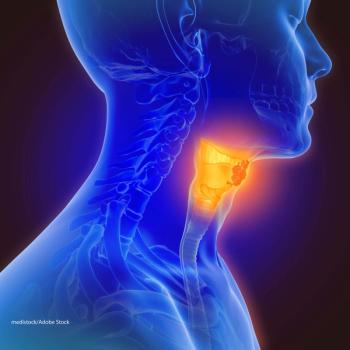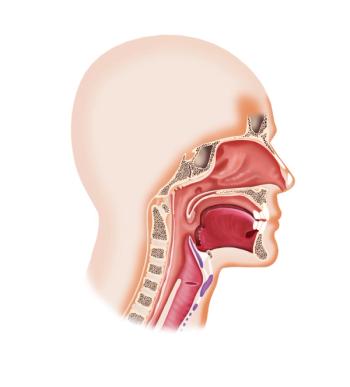
- ONCOLOGY Vol 16 No 6
- Volume 16
- Issue 6
The Role of Docetaxel in the Management of Squamous Cell Cancer of the Head and Neck
The activity of docetaxel (Taxotere) as a single agent (overall response rates, 24%-45%) in the treatment of patients with recurrent squamous cell cancer of the head and neck has resulted in the investigation of docetaxel-based doublet and triplet combinations in both the recurrent and neoadjuvant settings. When combined with cisplatin, with or without fluorouracil (5-FU), in the treatment of recurrent disease, response rates of 33% to 44% have been observed for docetaxel, with median survival ranging from 9.6 to 11 months. In the neoadjuvant setting, response rates have been typically greater than 90%, with promising disease-free and overall survival results.
ABSTRACT: The activity of docetaxel (Taxotere) as a single agent (overall response rates, 24%-45%) in the treatment of patients with recurrent squamous cell cancer of the head and neck has resulted in the investigation of docetaxel-based doublet and triplet combinations in both the recurrent and neoadjuvant settings. When combined with cisplatin, with or without fluorouracil (5-FU), in the treatment of recurrent disease, response rates of 33% to 44% have been observed for docetaxel, with median survival ranging from 9.6 to 11 months. In the neoadjuvant setting, response rates have been typically greater than 90%, with promising disease-free and overall survival results. Randomized trials are now under way to assess the value of docetaxel-based therapy relative to that of the standard cisplatin/5-FU combination in both the neoadjuvant and recurrent settings. Preclinical data indicate that docetaxel is a potent radiosensitizer and its initial evaluation with concurrent radiation in patients with locally advanced unresectable squamous cell cancer of the head and neck suggests feasibility. Phase II evaluation of this approach is in progress. [ONCOLOGY 16(Suppl 6):83-87, 2002]
TABLE 1
Docetaxel Monotherapy in Recurrent Squamous Cell Carcinoma of the Head and Neck
Table 1 describes the results of four studies evaluating the activity of docetaxel as monotherapy in patients with recurrent or incurable squamous cell cancer of the head and neck at presentation.[2-5] Three studies[2-4] evaluated docetaxel, 100 mg/m² every 3 weeks, and a Japanese study evaluated docetaxel, 60 mg/m² every 3 to 4 weeks.[5] As is true for most single-agent trials, the complete response rate is low. However, the average overall response rate of 35% compares favorably with other active drugs in this disease. For example, a pooled average overall response rate to cisplatin, historically the most active single agent in squamous cell cancer of the head and neck, is 28%.[6] Only the study of Couteau et al reported overall survival for single-agent docetaxel (median: 6.7 mo).[4] Docetaxel monotherapy is well tolerated, with predictable and uncomplicated myelosuppression as the most frequently noted side effect. Nonhematologic toxicities include asthenia, stomatitis, diarrhea, nausea, and vomiting.
TABLE 2
Docetaxel in Combination Chemotherapy for Recurrent Disease
Table 2 summarizes the results of five studies with docetaxel-based regimens in varying combinations with cisplatin, 5-FU, or both.[7-9,12,13] Two phase II studies investigated docetaxel at doses of 75 mg/m² or 100 mg/m² in combination with cisplatin at 75 mg/m² every 3 weeks for patients with squamous cell cancer of the head and neck that was locally advanced, recurrent, or metastatic.[7,8] Survival estimates of 9.6 to 11 months suggest a possible improvement over the median of 5 to 7 months generally observed with the cisplatin/5-FU combination.
Janinis et al studied the addition of docetaxel to cisplatin/5-FU in previously treated patients.[9] This regimen included docetaxel, 80 mg/m² on day 1, cisplatin, 40 mg/m² on days 2 and 3, and 5-FU, 1,000 mg/m² continuous infusion on days 1 to 3, and granulocyte colony-stimulating factor (G-CSF [Neupogen]) for 5 days following treatment. Cycles were repeated every 28 days. The regimen proved feasible for administration, prompting additional studies of the triplet combination.
Phase I studies of the docetaxel/5-FU combination in patients with advanced solid tumors indicated potentially promising activity in head and neck cancers.[10,11] However, comparatively low response rates (24%-27%) have been observed with the docetaxel/5-FU combination for squamous cell cancer of the head and neck in phase II studies.[12,13] This finding has also been noted in an ongoing randomized trial in which accrual to the docetaxel/5-FU arm has been suspended.
FIGURE 1
Phase III Randomized Trial (TAX 322)
Toxicity data from phase II docetaxel combination trials are of interest. While dose-limiting toxic effects with cisplatin/5-FU include mucositis with attendant dehydration and neuropathy associated with cisplatin at the 100 mg/m² dose, the docetaxel/cisplatin combinations (without 5-FU) have been devoid of severe mucosal toxicity. Instead, myelosuppressive effects and fatigue/asthenia have been more prominent. Febrile neutropenia and/or infection was a common cause of dose reduction or dose delay. However, the docetaxel/cisplatin regimen is clearly more convenient and less complex for the patient relative to cisplatin and 4- to 5-day infusional 5-FU.
The findings from phase II studies led to the development of the TAX 322 trial, originally a three-arm phase III trial with standard cisplatin/5-FU compared with two experimental arms of docetaxel/cisplatin and docetaxel/5-FU. As noted above, accrual to the latter arm has been suspended due to a low response rate. The study continues to accrue patients to the two remaining arms (Figure 1).
Docetaxel in the Neoadjuvant Setting
TABLE 3
Docetaxel / Cisplatin / Fluorouracil in the Neoadjuvant Setting
In the neoadjuvant therapy for patients with squamous cell cancer of the head and neck, clinical and pathologic complete response rates at the primary site have been shown to predict locoregional control following definitive radiation. The low primary site complete response rates achieved with established chemotherapy regimens (eg, cisplatin, 5FU) have led to the investigation of new agents and combinations. The work of Janinis et al demonstrated the feasibility of adding docetaxel to cisplatin and 5-FU, albeit with dose reduction, in the recurrent setting.[9] This triplet combination has also proven feasible as neoadjuvant therapy for patients with locoregionally advanced squamous cell cancer of the head and neck in three separate trials, TAX 017 (European), TAX 708 (US), and a Greek trial, recently reported in abstract form.[14-16] The regimens and the results of these studies are summarized in Table 3. Based on the high overall response rates and the high primary site clinical and pathologic complete responses, the TPF (docetaxel [Taxotere]/cisplatin [Platinol]/fluorouracil [5-FU]) regimen is now being tested in the TAX 324 study, a randomized trial of cisplatin/5-FU vs the same combination plus docetaxel as induction chemotherapy in the neoadjuvant setting. All patients who achieve response proceed to concurrent chemoradiation with weekly carboplatin. This trial is ongoing in North and South America and Europe (Figure 2).
FIGURE 2
Phase III Randomized Trial (TAX 324)
In a series of trials, Colevas et al at Dana-Farber Cancer Institute have investigated this same base combination (docetaxel, cisplatin, and 5-FU) with the addition of leucovorin, the so-called TPFL (docetaxel [Taxotere]/cisplatin [Platinol]/fluorouracil [5-FU]/leucovorin] regimen, in patients with locally advanced disease deemed curable.[17-19] Table 3 summarizes the results of these studies following the TPF reports.[15-18]
The earliest study, TPFL-5 [17], reported a 100% overall response rate and a 61% complete response rate; however, the regimen was associated with significant toxicity most commonly related to febrile neutropenia and mucositis. The TPFL-5 regimen required hospitalization for drug administration and, subsequently, for toxicity in greater than 40% of patients, despite prophylactic antibiotics and growth factor support. Therefore, Colevas et al modified TPFL-5 to a 4-day regimen that maintained the dose intensity of the original regimen but allowed G-CSF treatment 1 day earlier (TPFL-4).[18] This regimen was associated with reduced hospitalization rates (14%) for toxicity. Similar to the TPFL-5 regimen, the overall clinical (93%) and complete (63%) response rates were notably high.
An additional TPFL regimen has been evaluated in phase I trials, and preliminary results were reported in abstract form.[19] The regimen was designed to be administered in the outpatient setting using ambulatory infusion pumps for the 5-FU. Docetaxel was able to be dose escalated to 90 mg/m². Response rates remained high with this approach, and hospitalization rates were reduced. Mature data are not yet available from this third regimen in the TPFL series. Because leucovorin is not universally accepted as adding benefit to cisplatin/5-FU and because it adds to mucosal toxicity, it is unlikely that the TPFL regimens will gain broad acceptance. Further, the results of TAX 708[15] suggest that leucovorin does not add to the efficacy of the TPF regimen.
Preclinical data, both in vitro and in vivo, demonstrate the potent radiosensitizing activity of docetaxel and suggest independence of this effect from pure chemosensitivity.[20] Initial exploration of docetaxel with concurrent radiation for the treatment of squamous cell cancer of the head and neck has been preliminarily reported by Tishler et al at Dana-Farber Cancer Institute.[21] Patients in this trial had received induction chemotherapy and had persistent biopsy-positive disease at the primary site. Patients were treated with conventionally fractionated radiation and escalating doses of docetaxel, given weekly. With experience in 21 patients, a maximum tolerated dose of docetaxel at 25 mg/m²/wk was reported, with the major dose-limiting toxicity of severe and prolonged mucositis. Fourteen patients of the initial 21 treated were alive and without progressive disease at the time of this preliminary report in abstract form. Further investigations of concurrent approaches with docetaxel in altered fractionation regimens and in combination with cisplatin are ongoing.
Docetaxel has shown significant activity as a single agent in squamous cell cancer of the head and neck, adding to the therapeutic armamentarium of agents in the treatment of the disease. Given its mainly nonoverlapping toxicity profile and differing mechanism of cytotoxicity, docetaxel in combination with the established standard of cisplatin and 5-FU has proven feasible and promising in the neoadjuvant setting. Based on phase II evaluation, the combination of docetaxel and cisplatin can be considered as a reasonable option for therapy for recurrent disease. Ongoing phase III trials will further define the role of docetaxel in both the recurrent and/or metastatic setting, and as neoadjuvant chemotherapy for patients with cancer of the head and neck. Additional research initiatives will provide insights on how best to use docetaxel in concurrent chemoradiation approaches for patients with locally advanced disease.
References:
1. Braakhuis BJM, Kegel A, Welters MJP: The growth inhibiting effect ofdocetaxel in head and neck squamous cell carcinoma xenografts. Cancer Lett81:151-154, 1994.
2. Catimel G, Verweij J, Mattijssen V, et al: Docetaxel: An active drug forthe treatment of patients with advanced squamous cell carcinoma of the head andneck. EORTC Early Clinical Trials Group. Ann Oncol 5:533-537, 1994.
3. Dreyfuss AI, Clark JR, Norris CM, et al: Docetaxel: An active drug forsquamous cell carcinoma of the head and neck. J Clin Oncol 14:1672-1678, 1996.
4. Couteau C, Chouaki N, Leyvraz S, et al: A phase II study of docetaxel inpatients with metastatic squamous cell carcinoma of the head and neck. Br JCancer 81:457-462, 1999.
5. Ebihara S, Fujii H, Sasaki Y, et al: A late phase II study of docetaxel inpatients with head and neck cancer (HNC) (abstract 1425). Proc Am Soc Clin Oncol16:399a, 1997.
6. Vokes EE, Athanasiadis I: Chemotherapy for squamous cell carcinoma of thehead and neck: The future is now. Ann Oncol 7:15-29, 1996.
7. Specht L, Larsen SK, Hansen HS: Phase II study of docetaxel and cisplatinin patients with recurrent or disseminated squamous cell carcinoma of the headand neck. Ann Oncol 11:845-849, 2000.
8. Glisson B, Murphy B, Frenette G, et al: Phase II trial of docetaxel andcisplatin combination chemotherapy in patients with squamous cell carcinoma ofthe head and neck. J Clin Oncol 20:1593-1599, 2002.
9. Janinis J, Papadakou M, Xidakis E, et al: Combination chemotherapy withdocetaxel, cisplatin, and 5-fluorouracil in previously treated patients withadvanced/recurrent head and neck cancer. A phase II feasibility study. Am J ClinOncol 33:128-131, 2000.
10. Petit T, Aylesworth C, Burris H, et al: A phase I study of docetaxel and5-fluorouracil in patients with advanced solid malignancies. Ann Oncol10:223-229, 1999.
11. Van Den Neste E, de Valeriola D, Kerger J, et al: A phase I andpharmacokinetic study of docetaxel administered in combination with continuousintravenous infusion of 5-fluorouracil in patients with advanced solid tumors.Clin Can Res 6:64-71, 1999.
12. Colevas AD, Adak S, Amrein PC, et al: A phase II trial of palliativedocetaxel plus 5-fluorouracil for squamous cell cancer of the head and neck. AnnOncol 11:535-539, 2000.
13. Tubiana-Mathieu N, Genet D, Cupissol D, et al: Final results of phase IIstudy of patients with metastatic or recurrent squamous cell carcinoma of thehead and neck (SCCHN) treated with docetaxel (D) and 5-fluorouracil (5-FU)(abstract 1656). Proc Am Soc Clin Oncol 19:419a, 2000.
14. Schrijvers D, van Herpen C, Kerger J, et al: Phase I-II study withdocetaxel (D), cisplatin (C) and 5-fluorouracil (5-FU) in patients with locallyadvanced inoperable squamous cell carcinoma of the head and neck (SCCHN)(abstract 1524). Proc Am Soc Clin Oncol 18:394a, 1999.
15. Posner MR, Glisson B, Frenette G, et al: Multicenter phase I/II trial ofdocetaxel, cisplatin, and fluorouracil induction chemotherapy for patients withlocally advanced squamous cell cancer of the head and neck. J Clin Oncol19:1096-1104, 2001.
16. Janinis J, Papadakou M, Xidakis E, et al: Final Survival Analysis ofpatients with locally advanced head and neck cancer (HNC) treated withsequential chemoradiotherapy with docetaxel, cisplatin and 5-FU (DCF) (abstract2554) Proc Am Soc Clin Oncol 20:201b, 2001.
17. Colevas AD, Busse PM, Norris CM, et al: Induction chemotherapy withdocetaxel, cisplatin, fluorouracil, and leucovorin for squamous cell carcinomaof the head and neck: A phase I/II trial. J Clin Oncol 16:1331-1339, 1998.
18. Colevas AD, Norris CM, Tishler RB, et al: Phase II trial of docetaxel,cisplatin, fluorouracil, and leucovorin as induction for squamous cell carcinomaof the head and neck. J Clin Oncol 17:3503-3511, 1999.
19. Colevas AD, Tishler R, Fried M, et al: A phase I/II study of outpatientdocetaxel (Taxotere), cisplatin, 5-FU, and leucovorin (OP-TPFL) as inductionchemotherapy for patients with squamous cell carcinoma of the head and neck (SCCHN)(abstract 1660). Proc Am Soc Clin Oncol 19:420a, 2000.
20. Mason K, Hunter N, Milas M, et al: Docetaxel enhances tumor radioresponsein vivo. Clin Cancer Res 3:2431-2438, 1997.
21. Tishler R, Colevas AD, Norris CM, et al: A phase I/II trial of concurrentdocetaxel (T) and once daily radiation following induction chemotherapy insquamous cell cancer of the head and neck (abstract 930). Proc Am Soc Clin Oncol20:233a, 2001.
Articles in this issue
over 23 years ago
Cutting-Edge PET/CT Scanner Is Clinically Operationalover 23 years ago
Textbook of Lung Cancerover 23 years ago
Screening Agent Helps Detect Prostate Cancer Recurrence Earlierover 23 years ago
Oncology Care Included in Medicare Disease Management Demonstrationsover 23 years ago
Liquid Pamidronate Disodium Injection Approvedover 23 years ago
Medical Liability Reform ResurrectedNewsletter
Stay up to date on recent advances in the multidisciplinary approach to cancer.
































































































